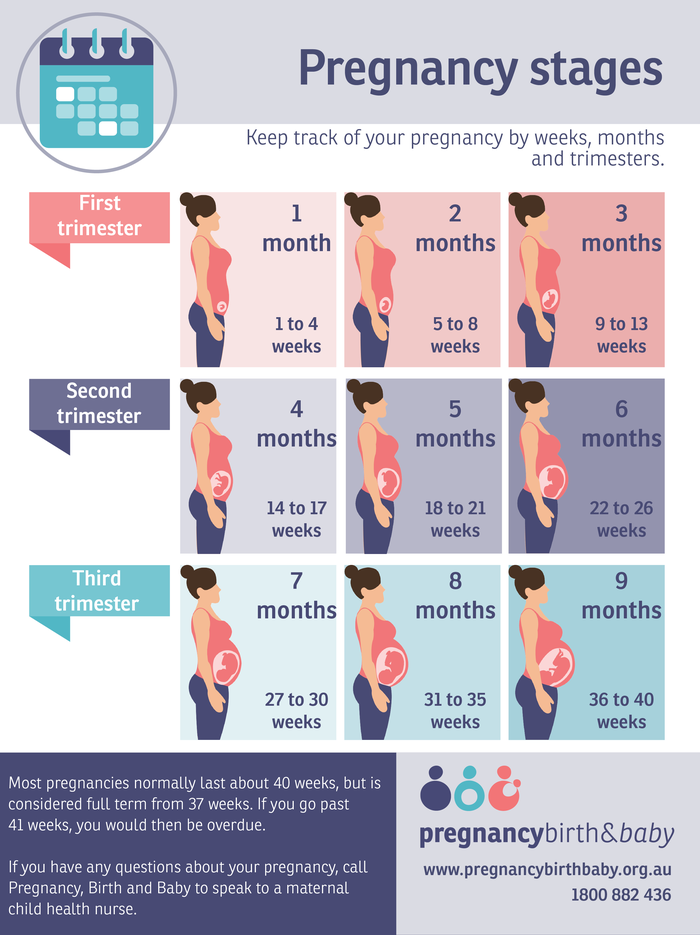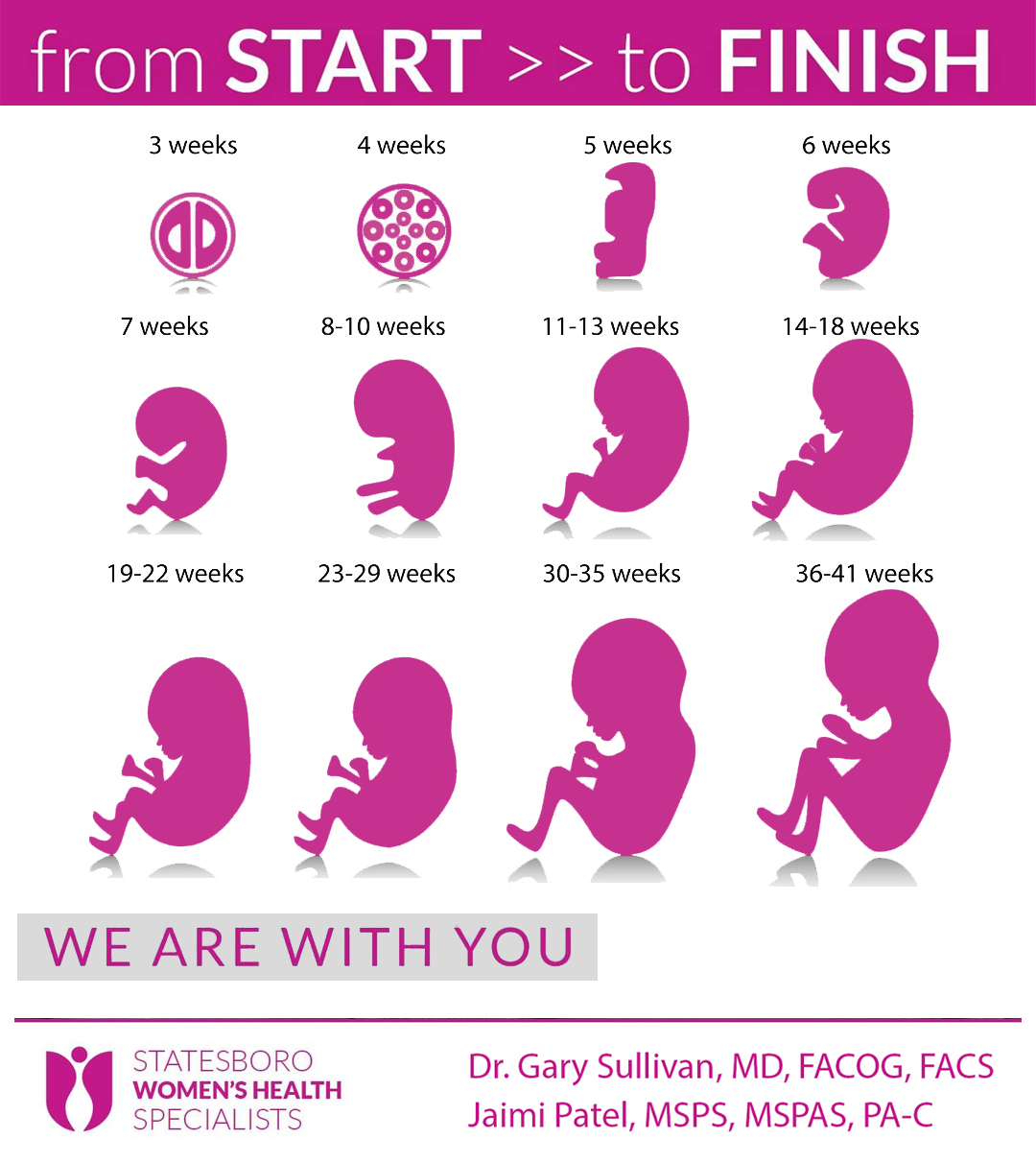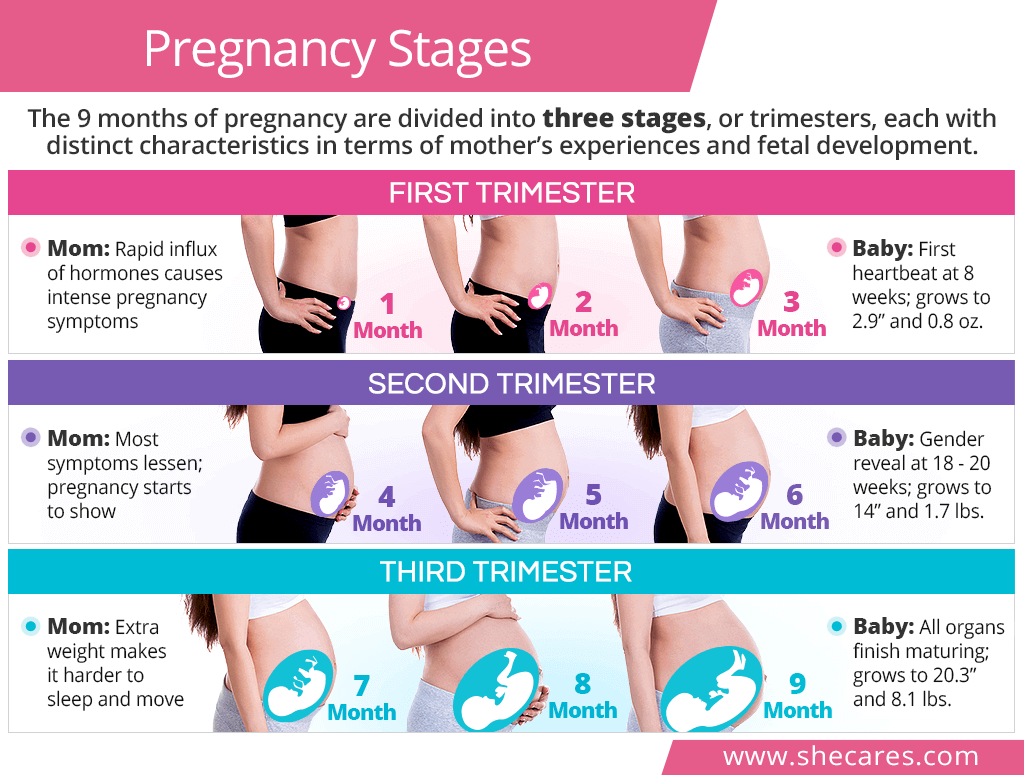Pregnancy stages consist of three trimesters, each lasting about 13 weeks. These stages mark key developments for both mother and baby.
Pregnancy is a transformative journey that lasts about nine months, divided into three distinct trimesters. Each trimester brings unique changes in a woman’s body and crucial developments in the fetus. During this time, expectant mothers experience various physical and emotional shifts as they prepare for childbirth.

Understanding these stages helps expectant parents navigate the journey more effectively. From early signs of pregnancy to the final weeks before delivery, each stage holds significant milestones. Knowledge about pregnancy stages can empower parents with insights on what to expect, making the experience smoother and more informed. Awareness of these changes enhances the bond between parents and their unborn child.

Credit: statesboro.com
Introduction To Pregnancy Stages
Understanding pregnancy stages is essential for expectant parents. Each stage represents unique developments. Knowledge helps prepare for the journey ahead.
Setting The Stage
Pregnancy is divided into three main trimesters. Each trimester has distinct characteristics. Here’s a brief overview:
| Trimester | Duration | Key Developments |
|---|---|---|
| First Trimester | Weeks 1-12 | Organ formation, early symptoms. |
| Second Trimester | Weeks 13-26 | Growth, movement, gender reveal. |
| Third Trimester | Weeks 27-40 | Final growth, preparation for birth. |
During each trimester, expectant parents will notice changes. Physical and emotional shifts occur throughout pregnancy. Staying informed helps manage these transitions.
The Importance Of Knowing Pregnancy Phases
Knowing each pregnancy phase is crucial for several reasons:
- Health Monitoring: Track maternal and fetal health.
- Preparation: Plan for doctor visits and baby needs.
- Education: Learn about childbirth and parenting.
- Support: Build a support network for advice.
Each phase of pregnancy comes with its own challenges. Understanding these can ease anxiety. Knowledge empowers parents to make informed decisions.

Credit: healthbanks.us
First Trimester: The Beginning
The first trimester is a crucial period in pregnancy. It lasts from week 1 to week 12. During this time, many important changes occur. The baby begins to develop rapidly. Expecting mothers may experience various symptoms. This phase sets the foundation for a healthy pregnancy.
Weeks 1-4: Early Development
In the first four weeks, many changes happen:
- The fertilized egg implants in the uterus.
- The body starts producing hormones.
- Some women may miss their periods.
- Early pregnancy symptoms like nausea may begin.
Cells divide rapidly. They start to form a blastocyst. This blastocyst will grow into a baby. The placenta and umbilical cord also begin to form.
Weeks 5-8: Vital Organs Begin To Form
During weeks five to eight, the baby’s organs start to develop:
| Week | Organ Development |
|---|---|
| 5 | Heart begins to beat. |
| 6 | Brain and spinal cord start to form. |
| 7 | Arms and legs begin to develop. |
| 8 | Vital organs like lungs and liver start forming. |
This is an exciting time for fetal development. The baby begins to look more human. Expecting mothers may notice more intense pregnancy symptoms.
Weeks 9-12: The Fetal Period Commences
Weeks nine to twelve mark the start of the fetal period:
- The baby’s body continues to grow.
- All major organs are formed.
- Fingers and toes become visible.
- The baby begins to move, though the mother may not feel it.
By the end of the first trimester, the baby is about 2.5 inches long. It weighs around half an ounce. This period is vital for development.
Regular check-ups are important. They help monitor the baby’s growth. Expecting mothers should maintain a healthy lifestyle. Proper nutrition and hydration are key.
Second Trimester: Growth And Development
The second trimester is an exciting time in pregnancy. It spans from week 13 to week 26. During this phase, significant changes occur in both the baby and the mother. Expect rapid growth and important developmental milestones. Let’s explore each stage in detail.
Weeks 13-16: Baby’s Features Develop
In weeks 13 to 16, the baby undergoes remarkable changes:
- Facial Features: The baby’s face becomes more defined.
- Eyes: Eyelids close, and eyes begin to develop color.
- Limbs: Arms and legs grow longer and more proportionate.
- Fingers and Toes: They become distinct and separate.
This is also a time when the baby can move, although the mother may not feel it yet. The baby is about the size of a peach by week 16.
Weeks 17-20: Sensory Development
From weeks 17 to 20, the baby’s senses start to develop:
- Hearing: The baby can hear sounds from outside.
- Touch: Skin becomes sensitive; the baby can feel sensations.
- Taste: The baby begins to taste amniotic fluid.
This period marks a significant leap in sensory abilities. The baby is around the size of a banana by week 20.
Weeks 21-24: Viability And Movement
In weeks 21 to 24, the baby’s development reaches new heights:
- Movement: The mother may feel the baby kicking and rolling.
- Viability: Babies born at this stage can survive with medical help.
- Size: The baby is about the size of an ear of corn.
This phase is crucial for lung development. The baby practices breathing movements.

Credit: www.shecares.com
Third Trimester: The Final Stretch
The third trimester is an exciting time for expectant parents. It lasts from week 28 until birth. This stage focuses on rapid baby growth and preparing for delivery. Understanding what happens in each phase helps parents feel ready.
Weeks 25-28: Rapid Growth
During weeks 25 to 28, your baby experiences significant growth. The baby gains fat and muscle, becoming more active.
- Baby measures about 14 inches long.
- Weight increases to about 2.5 pounds.
- Organs develop further, including the lungs and brain.
Expect more movement. You may feel kicks and rolls. This is a sign of a healthy baby.
Weeks 29-32: Baby’s Descent
From weeks 29 to 32, your baby begins to settle lower in your pelvis. This position helps prepare for birth.
| Week | Baby’s Size | Weight |
|---|---|---|
| 29 | 15 inches | 2.5-3 pounds |
| 30 | 15.5 inches | 3-3.5 pounds |
| 31 | 16 inches | 3.5-4 pounds |
| 32 | 16.5 inches | 4-4.5 pounds |
As the baby descends, you may feel pressure in your lower abdomen. This is normal and part of the process.
Weeks 33-36: Preparing For Birth
Weeks 33 to 36 are all about preparation. Your body gets ready for labor and delivery.
- Baby’s lungs mature for breathing.
- Head may engage in the pelvis.
- Weight gain continues; baby reaches about 5-6 pounds.
Discuss your birth plan with your doctor. Consider classes to learn about labor and delivery. Stay active, but rest when needed.
Weeks 37-40: Full Term
Weeks 37 to 40 mark full term. Your baby is ready for the world!
- Baby weighs between 6-9 pounds.
- Length is about 19-21 inches.
- All organs function well, especially the lungs.
Watch for signs of labor. Be prepared to go to the hospital. Stay calm and remember you are almost there!
Stay Connected with Google News
Prenatal Care And Checkups
Prenatal care is crucial for a healthy pregnancy. It involves regular checkups and screenings. These appointments help monitor the health of both mother and baby. Early detection of issues can lead to better outcomes.
First Trimester Checkups
The first trimester spans from week 1 to week 12. Early checkups are vital during this stage. Your healthcare provider will:
- Confirm the pregnancy with a blood or urine test.
- Calculate your due date based on your last menstrual period.
- Conduct a thorough health history assessment.
- Discuss lifestyle changes for a healthy pregnancy.
Expect to have a physical exam and some lab tests. Common tests include:
| Test | Purpose |
|---|---|
| Blood Test | Check for anemia and infections. |
| Urine Test | Screen for diabetes and kidney issues. |
| Ultrasound | Confirm fetal heartbeat and check development. |
Second Trimester Screenings
The second trimester lasts from week 13 to week 26. This period includes important screenings. Common tests are:
- Quad screen: Checks for genetic disorders.
- Anatomy ultrasound: Assesses fetal development and anatomy.
These tests help identify potential health issues. Your healthcare provider will explain results and next steps.
Third Trimester Preparations
The third trimester runs from week 27 to birth. Regular checkups become more frequent. Expect to:
- Monitor fetal growth and position.
- Check blood pressure and weight.
- Discuss labor and delivery plans.
Prepare for your baby’s arrival. Consider taking childbirth classes. Create a birth plan that reflects your preferences.
Common Symptoms And Health Tips
Pregnancy brings many changes. Each trimester has its own symptoms. Understanding these symptoms helps manage discomfort. Here are some common symptoms and health tips for each trimester.
Managing First Trimester Discomfort
The first trimester can be challenging. Many women experience nausea, fatigue, and mood swings. Here are some tips to ease these symptoms:
- Stay Hydrated: Drink plenty of water. This helps reduce nausea.
- Eat Small Meals: Eating small meals throughout the day can help. Focus on bland foods.
- Rest: Take naps when needed. Your body is working hard.
- Avoid Strong Smells: Keep away from strong odors that trigger nausea.
Second Trimester Energy Boost
The second trimester often brings more energy. Many women feel better during this time. Some common symptoms include back pain and cravings. Here are tips to stay healthy:
- Exercise Regularly: Light exercises like walking help boost energy.
- Balanced Diet: Include fruits, vegetables, and whole grains in meals.
- Mindful Eating: Listen to your body’s cravings, but choose healthy options.
- Stay Active: Engage in activities you enjoy to keep spirits high.
Third Trimester Physical Changes
The third trimester brings significant physical changes. Many women experience swelling, heartburn, and fatigue. Here are some tips to cope:
| Symptom | Health Tip |
|---|---|
| Swelling | Elevate your feet when resting. |
| Heartburn | Eat smaller meals and avoid spicy foods. |
| Fatigue | Get enough sleep and take breaks during the day. |
Stay in touch with your healthcare provider. They can help manage any concerns. Pregnancy is a unique journey. Prioritize your health and well-being.
Nutrition And Lifestyle During Pregnancy
Pregnancy is a time of change. Proper nutrition and lifestyle choices support both mother and baby. Healthy habits can make a big difference. Focus on balanced meals and safe activities. This ensures a healthy pregnancy journey.
Eating For Two: Diet Guidelines
Eating for two means making smart food choices. Aim for a balanced diet rich in nutrients. Here are some key guidelines:
- Fruits and Vegetables: Eat a variety of colors.
- Whole Grains: Choose brown rice, whole wheat bread, and oats.
- Lean Proteins: Include chicken, fish, beans, and nuts.
- Dairy: Opt for low-fat milk, yogurt, and cheese.
Stay hydrated. Drink plenty of water each day. Limit sugary drinks and caffeine. Avoid processed foods high in sugar and salt.
Staying Active: Safe Exercises
Exercise is important during pregnancy. It helps maintain energy and reduces stress. Here are some safe activities:
- Walking: Easy and low-impact.
- Swimming: Gentle on joints and muscles.
- Yoga: Improves flexibility and relaxation.
- Pelvic Floor Exercises: Strengthen muscles for labor.
Always consult with a doctor before starting any exercise program. Listen to your body. Stop if you feel discomfort.
Lifestyle Adjustments For A Healthy Pregnancy
Making lifestyle changes can enhance well-being. Focus on these adjustments:
- Quit Smoking: Avoid tobacco for a healthier baby.
- Limit Alcohol: No alcohol during pregnancy.
- Manage Stress: Practice relaxation techniques.
- Regular Check-ups: Attend all prenatal appointments.
Get enough sleep. Aim for 7-9 hours each night. Surround yourself with supportive friends and family. A healthy environment fosters well-being.
Preparing For Childbirth
Preparing for childbirth is an exciting and crucial phase of pregnancy. This stage involves making important decisions that can influence your birthing experience. Understanding your options helps you feel confident and ready for the big day.
Choosing A Birth Plan
Your birth plan outlines your preferences for labor and delivery. It covers choices about pain relief, support people, and newborn care.
- Consider Your Preferences: Think about your ideal birthing environment.
- Discuss with Your Partner: Talk about your wishes and concerns.
- Consult Your Healthcare Provider: Get advice on what is possible.
Remember, flexibility is key. Birth plans can change as labor progresses.
Childbirth Education Classes
Childbirth education classes prepare you for labor and delivery. These classes cover various topics, including:
| Topic | Description |
|---|---|
| Labor Stages | Learn about the different phases of labor. |
| Pain Management | Explore options like medication and breathing techniques. |
| Newborn Care | Understand how to care for your baby after birth. |
These classes help build confidence and reduce anxiety. You will meet other expecting parents too.
Packing The Hospital Bag
Having a well-packed hospital bag is essential. Aim to pack it around 36 weeks of pregnancy. Include items for both you and your baby.
- For Mom:
- Comfortable clothes
- Toiletries
- Snacks
- Phone charger
- For Baby:
- Outfits
- Blanket
- Diapers
Check with your hospital for specific recommendations. Being prepared helps you focus on your birthing experience.
Postpartum Recovery And Care
Postpartum recovery is a vital phase after childbirth. It involves physical healing and emotional adjustment. New mothers experience many changes during this period. Understanding these changes helps in better care and recovery.
The First Weeks After Birth
The initial weeks after birth can be challenging. The body begins to heal from delivery. Here are some common experiences:
- Vaginal Discomfort: Expect soreness and possible swelling.
- Bleeding: Light bleeding called lochia occurs for weeks.
- Fatigue: Lack of sleep can lead to extreme tiredness.
Take time to rest and bond with your baby. Consider asking for help from family or friends.
Physical And Emotional Changes
Physical changes are normal after childbirth. Hormonal shifts can affect mood. Some common physical changes include:
| Change | Description |
|---|---|
| Breast Changes | Breasts may feel full and tender as they produce milk. |
| Weight Loss | Many women lose weight in the weeks after delivery. |
| Uterine Contractions | The uterus shrinks back to its normal size. |
Emotional changes are also common. Many new mothers feel:
- Joy: Bonding with the baby can bring happiness.
- Sadness: Baby blues may occur due to hormonal shifts.
- Overwhelmed: New responsibilities can feel daunting.
It is essential to talk about these feelings. Seek support from loved ones or professionals.
Postpartum Checkups And Support
Regular postpartum checkups are crucial. They help monitor recovery progress. Schedule your first checkup within six weeks after birth.
During your visit, your doctor will:
- Assess physical healing.
- Discuss emotional health.
- Provide guidance on breastfeeding and infant care.
Support systems are important during this time. Consider joining a new mothers’ group. Sharing experiences can help ease feelings of isolation.
Always reach out for help. Prioritize your health and well-being during this transformative phase.
What are the Most Important Stages of Pregnancy?
The most important stages of pregnancy are the first trimester, second trimester, and third trimester. Each stage plays a crucial role in fetal development and maternal health.
Pregnancy is a transformative journey divided into three main trimesters. The first trimester spans from conception to 12 weeks and is vital for early development. This phase includes significant changes in the mother’s body and the formation of major organs in the fetus.
The second trimester, lasting from weeks 13 to 26, brings noticeable physical changes and increased energy for many women. During this time, the baby’s features become more defined. The third trimester, from weeks 27 until birth, focuses on growth and preparation for delivery. Understanding these stages helps expectant parents navigate this incredible experience and ensure a healthy pregnancy.
The First Trimester: A Critical Beginning
The first trimester is a crucial time in pregnancy. It begins with conception. This is when the sperm meets the egg. After fertilization, the egg travels to the uterus and implants itself. This process is vital for the start of a healthy pregnancy.
During early development, the embryo forms important structures. These include the heart, brain, and spinal cord. Prenatal care is essential during this stage. Regular check-ups help monitor the mother’s health and the baby’s growth. Taking prenatal vitamins is also important. They provide essential nutrients like folic acid.
The Second Trimester: Growth And Development
The second trimester is a time of significant growth for the fetus. By week 13, the fetus measures about 3 inches long. By week 20, it can grow to about 10 inches. This period sees the development of organs and senses. The fetus can hear sounds and feel touch.
Maternal health also changes during this time. Many women experience less nausea and more energy. The belly starts to show as the baby grows. Regular check-ups become more important for monitoring health. Staying active and eating nutritious foods can help support both mother and baby.
The Third Trimester: Preparing For Birth
The third trimester is crucial for final fetal development. During this time, the baby grows rapidly. Organs mature and prepare for life outside the womb. The brain develops significantly in these weeks. This growth helps the baby with breathing and regulating body temperature after birth.
Labor and delivery preparation is essential. Parents should attend birthing classes to learn about the process. Understanding the signs of labor is important. Creating a birth plan can help express preferences. Packing a hospital bag ahead of time eases last-minute stress. Stay informed about potential delivery options.
Understanding the stages of pregnancy is crucial for expectant parents. Each phase brings unique changes and experiences. By recognizing these stages, you can better prepare for the journey ahead. Staying informed and seeking support will help you navigate this exciting time.
At What Stage are You Pregnant?
You are pregnant as soon as a fertilized egg implants in your uterus. This typically occurs about six to ten days after conception.
Pregnancy is an exciting journey that begins with conception, when a sperm fertilizes an egg. Understanding the stages of pregnancy helps expectant mothers prepare for the changes ahead. Pregnancy is divided into three trimesters, each with distinct developments for both mother and baby.
The first trimester includes crucial early growth, while the second trimester brings noticeable physical changes. The third trimester prepares the body for labor and delivery. Knowing where you are in your pregnancy helps you track milestones and health needs. This knowledge can empower you to make informed decisions for a healthy pregnancy.
Early Pregnancy Signs And Symptoms
Early pregnancy brings many changes to the body. Common physical changes include missed periods and breast tenderness. Women may also experience nausea or vomiting, often called morning sickness. Fatigue is another common symptom during this stage.
During early pregnancy, emotional and hormonal shifts occur. Mood swings can happen due to hormonal changes. Some women feel more emotional than usual. Increased sensitivity is also common. These changes can be surprising but are a normal part of pregnancy.
Trimester Breakdown: Growth And Development
The first trimester lasts from week 1 to week 12. During this time, the baby’s organs begin to form. This is a crucial period for development. Expectant mothers may experience fatigue and morning sickness.
The second trimester spans from week 13 to week 26. This phase often brings relief from nausea. The baby grows quickly, and movement becomes noticeable. Many women feel more energetic during this time.
The third trimester starts at week 27 and lasts until birth. The baby gains weight and prepares for delivery. Common symptoms include back pain and trouble sleeping. Regular check-ups become important for monitoring both mother and baby.
Medical Milestones And Tests
Your first prenatal visit is very important. This visit usually happens around 8 to 12 weeks of pregnancy. Your doctor will check your health and the baby’s health. They may ask about your medical history and any medications.
Ultrasound is a key test during pregnancy. It helps check the baby’s growth and development. This test usually occurs in the first trimester. Your doctor may also suggest genetic screening. This screening checks for genetic disorders in the baby.
The glucose tolerance test is essential too. It checks for gestational diabetes. This test is usually done between 24 and 28 weeks. Early detection can help manage your health and the baby’s health effectively.
Understanding your pregnancy stage is crucial for your health and your baby’s development. Each trimester brings unique changes and experiences. Regular check-ups and monitoring are essential to ensure a healthy pregnancy journey. Stay informed and embrace this exciting time, as knowledge empowers you to make the best choices for you and your child.
How Do I Know My Pregnancy Stage?
To determine your pregnancy stage, track your last menstrual period (LMP) or use an ultrasound for accuracy. This information helps calculate gestational age and due date.
Understanding your pregnancy stage is crucial for monitoring your health and your baby’s development. Pregnancy is typically divided into three trimesters, each lasting about three months. The first trimester includes weeks 1 to 12, the second from weeks 13 to 26, and the third from weeks 27 to 40.
Knowing your stage can guide you in seeking appropriate prenatal care and preparing for childbirth. Regular check-ups with your healthcare provider will help ensure a healthy pregnancy journey. Awareness of your pregnancy stage also aids in understanding symptoms and making informed decisions for both you and your baby.
Identifying Pregnancy Trimesters
The first trimester lasts from week 1 to week 12. Common signs include nausea, fatigue, and breast tenderness. Many women experience mood swings and frequent urination during this stage.
The second trimester is from week 13 to week 26. Changes like a growing belly and increased energy are typical. Some women notice quickening, which is feeling the baby move.
The third trimester lasts from week 27 until birth. Expect more discomfort as the baby grows. Key milestones include regular doctor visits and preparing for labor and delivery.
Key Pregnancy Milestones
Missed periods often signal the start of pregnancy. Early symptoms may include nausea, fatigue, and breast tenderness. These signs help determine if you are pregnant.
During the first ultrasound, you can see your baby. This scan shows the baby’s heartbeat and helps measure growth. It’s an exciting moment for parents.
As the pregnancy progresses, preparing for delivery becomes essential. Consider making a birth plan. Pack a hospital bag with necessary items. Attending prenatal classes can also be beneficial.
Tracking Progress With Tools And Tests
Tracking your pregnancy stage is important. A pregnancy calendar helps you know your week. It shows the baby’s growth and important milestones. You can find these calendars online or in books.
Prenatal check-ups are essential for both mom and baby. Regular visits help doctors monitor health. They can catch any issues early. Following a schedule ensures you get the needed tests.
Home monitoring techniques can also help. You can track your symptoms and baby movements. Keeping a journal is a good way to stay organized. It helps you communicate with your doctor better.
Understanding your pregnancy stage is vital for your health and your baby’s development. Regular check-ups and tracking symptoms can help. Use reliable resources and consult your healthcare provider for personalized advice. Being informed empowers you to make the best choices throughout your pregnancy journey.
What are the Five Stages of Pregnancy?
The five stages of pregnancy are the germinal stage, embryonic stage, fetal stage, labor, and postpartum. These stages collectively span approximately 40 weeks of gestation.
Pregnancy is a remarkable journey that transforms a woman’s body and life. Understanding the five stages helps expectant mothers prepare for the changes ahead. Each stage plays a crucial role in fetal development, from conception to birth. The germinal stage marks the beginning, while the embryonic and fetal stages focus on growth and organ development.
Labor signifies the transition to parenthood, followed by postpartum recovery. Being informed about these stages can enhance your pregnancy experience and promote better health for both mother and child. Expecting parents should embrace this exciting time with knowledge and support.
The Journey Begins: First Trimester
The first trimester marks the beginning of the pregnancy journey. Many women experience early signs and symptoms. Common signs include nausea, fatigue, and breast tenderness. These symptoms can vary in intensity.
During the first trimester, fetal development is rapid. By the end of this stage, the baby is about 3 inches long. Major organs and systems begin to form. This includes the heart, brain, and spine. By week 12, the baby can move and kick.
|
Week |
Milestone |
|---|---|
|
4 |
Heart begins to beat |
|
8 |
Major organs start developing |
|
12 |
Fingers and toes form |
Growth And Changes: Second Trimester
During the second trimester, many expectant mothers feel the first kicks. These movements are exciting and can happen between weeks 16 and 25. Each kick is a sign that the baby is growing stronger.
Ultrasounds play a crucial role during this stage. They help monitor the baby’s development and health. Many parents also learn their baby’s gender during these scans. This moment can bring great joy and anticipation.
Understanding the changes in your body is essential. The second trimester often brings increased energy and reduced nausea. Each day offers new experiences as the baby continues to grow.
Final Stretch: Third Trimester
As the third trimester begins, preparing for birth becomes essential. Parents should attend childbirth classes to understand the process. Creating a birth plan helps communicate preferences with healthcare providers.
Monitoring the baby’s position is vital. Most babies settle into a head-down position by this stage. Regular ultrasound scans can confirm the baby’s orientation. If the baby is in a breech position, doctors may discuss options for delivery.
Staying active can also help with labor. Gentle exercises like walking can encourage the baby to move. Always consult with a healthcare provider before starting any new activity.
Understanding the five stages of pregnancy is crucial for expectant parents. Each stage brings unique changes and experiences. By knowing what to expect, you can better prepare for this incredible journey. Embrace the joys and challenges of pregnancy, as they shape your family’s future and create lasting memories.
Frequently Asked Questions
What Are The Main Pregnancy Stages?
Pregnancy consists of three main stages: first trimester, second trimester, and third trimester, each lasting about three months.
How Long Does Each Pregnancy Stage Last?
Each stage of pregnancy lasts approximately three months, totaling around nine months for the entire pregnancy.
What Happens In The First Trimester?
The first trimester involves embryo development, hormone changes, and early symptoms like nausea and fatigue.
What Changes Occur In The Second Trimester?
During the second trimester, the fetus grows rapidly, and symptoms often improve; many women feel more energetic.
What Should I Expect In The Third Trimester?
The third trimester includes significant fetal growth, increased discomfort, and preparations for labor and delivery.
How Can I Track My Pregnancy Stages?
Use a pregnancy app or calendar to monitor stages, symptoms, and milestones throughout your pregnancy journey.
What Are Common Symptoms In Each Stage?
Symptoms vary: first trimester often includes nausea, second might see a baby bump, and third can bring back pain.
Why Is Prenatal Care Important During Pregnancy?
Prenatal care ensures the health of both mother and baby, monitoring development and addressing any potential complications.
Conclusion
Understanding the stages of pregnancy is essential for expectant parents. Each stage brings unique changes and experiences. Staying informed helps you prepare for the journey ahead. Embrace each moment, as they all contribute to the miracle of life. Knowledge empowers you to navigate this incredible time with confidence and joy.




